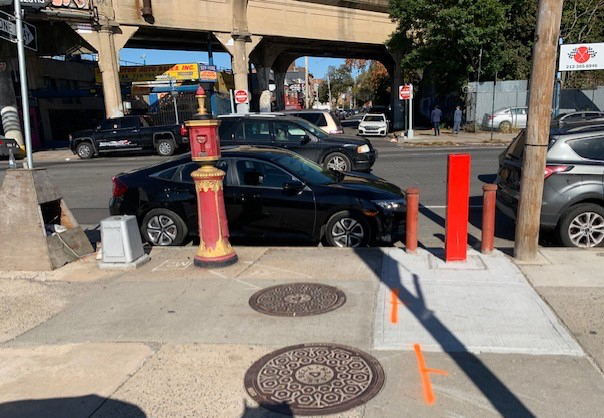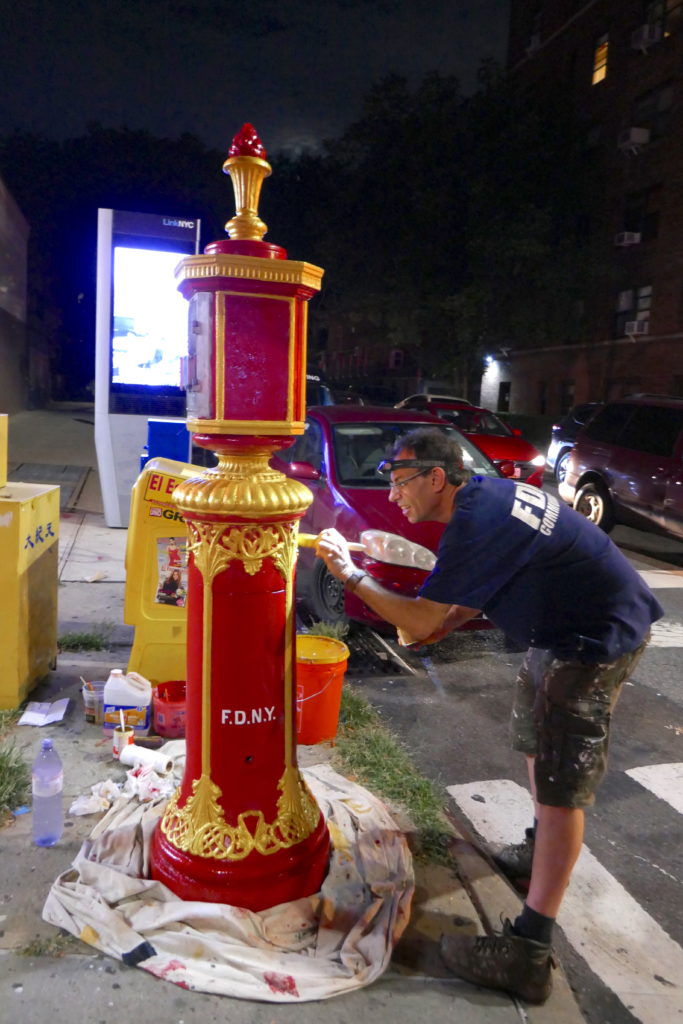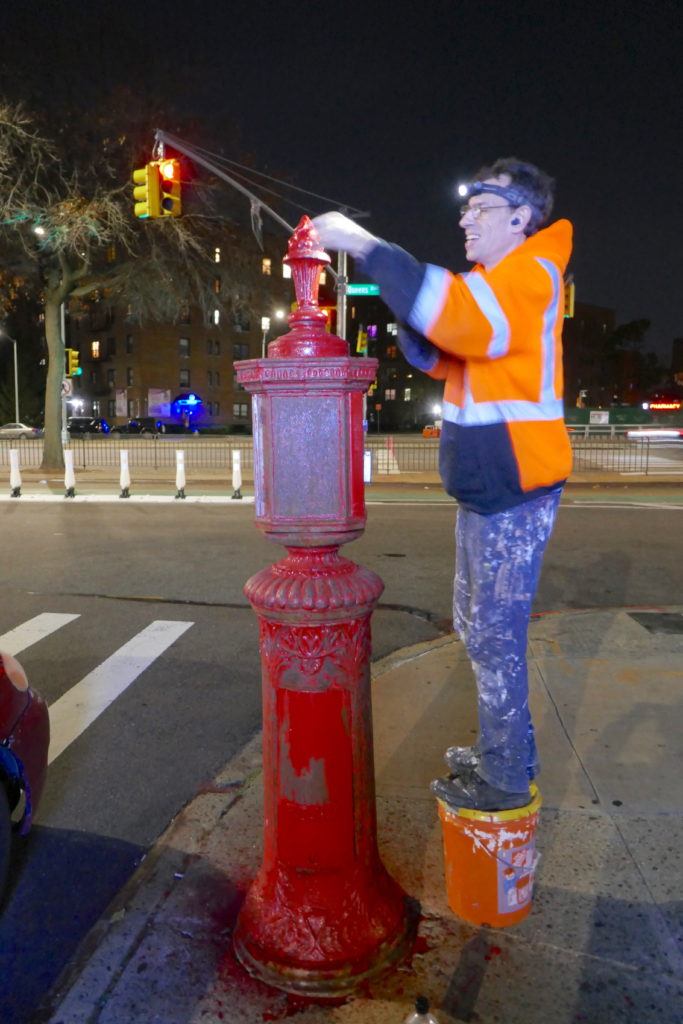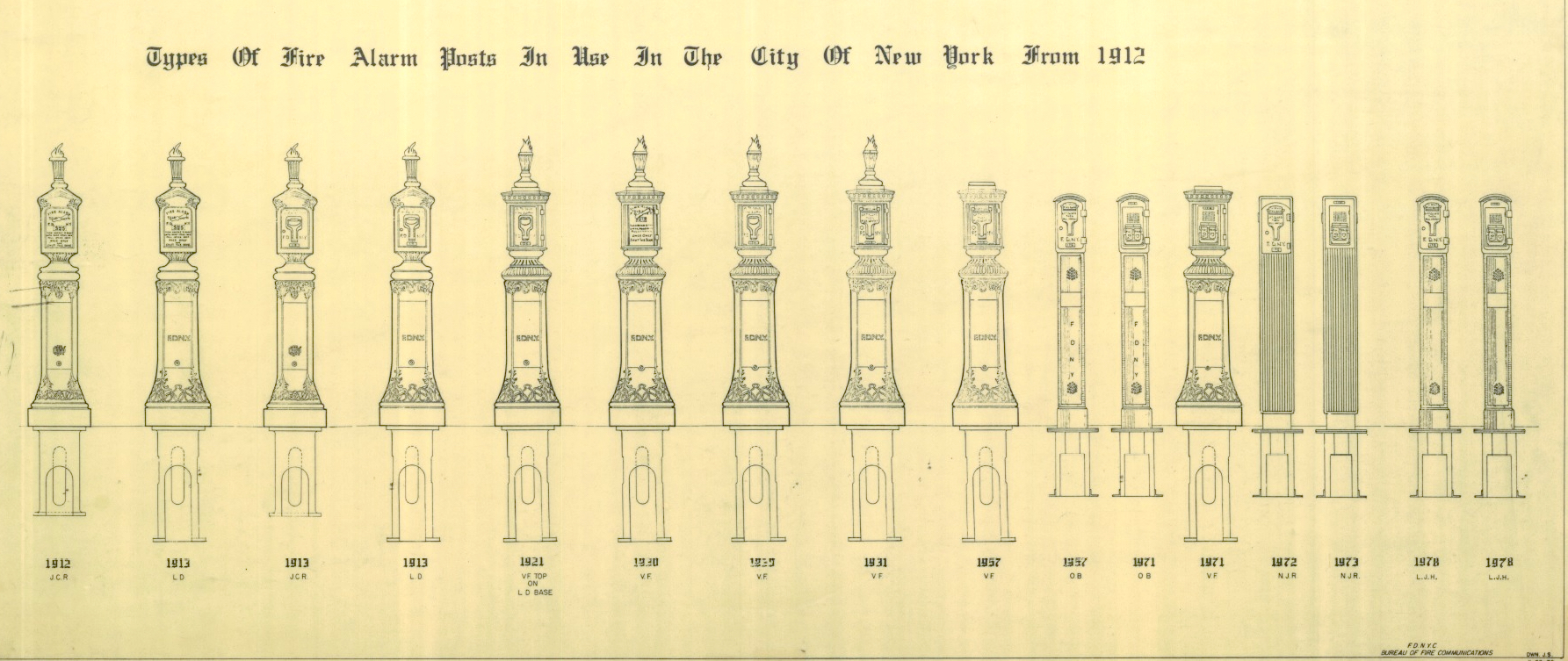Joining forces after a restored fire alarm pedestal vanishes
By Michael Perlman
mperlman@queensledger.com

Northern Blvd & 55th St, The now missing historic alarm side by side with its plain replacement, Photo courtesy of FDNY.
For over a decade, Woodside resident and volunteer John S. Colgan, nicknamed the “Fire Alarm Box Guy,” has meticulously restored historic cast-iron V.F. (Valentine Fendrich) fire alarm box pedestals.
But without any individually landmarked via the NYC Landmarks Preservation Commission, some are being removed, including one of Colgan’s restored models in Woodside.
In an age of rapid demolition, residents worry that another chapter of the city’s historic character is further being diminished.
A couple of weeks ago, some locals, including Colgan, were devastated to learn that Box No. 7802, a 1921 V.F. pedestal on Northern Boulevard and 55th Street in Woodside, was removed and replaced with a plain rectangular 1950s-style O’Brien model a few feet away.
“Ten years ago, my mother gave me some money and told me, ‘Go paint and clean the neighborhood.’ No one could have known that simple gesture would lead me a decade later to advocating for the preservation of the FDNY fire alarms,” Colgan said.

John Colgan applying finishing touches, V.F. model, 67th Ave & Queens Blvd, Photo by Michael Perlman.
Today, there are an estimated 15,077 fire alarm boxes citywide. A majority of the ornate V.F. models date to 1913, 1921 and 1931, whereas the 1950s non-descript O’Brien models have a prototype dating to 1947.
The historic treasures exhibit Beaux Arts meets Art Nouveau vine-like lacework, topped by a torch, where details are often enhanced in gold to accentuate their craftsmanship.
This columnist helped Colgan survey Forest Hills and Rego Park’s historic pedestals and actively supported the restoration process.
Locally, Colgan dedicated a year toward restoring a circa 1929 model on 67th Avenue and Queens Boulevard, which was completed in August, followed by another on 66th Avenue and Queens Boulevard, where restoration is now underway.
Each of Colgan’s restoration projects becomes a public show, as witnessed by passersby who gain an education on their history and intricate nature behind restoration.
As a result, an online petition was posted a week ago, requesting NYC Individual Landmark status for all remaining historic pedestals, a halt on their removal by the FDNY and a reversal on the ones that were already removed.
So far, the petition garnered nearly 600 signatures plus comments.

John Colgan restoring the 66th Ave & Queens Blvd V.F. pedestal, Photo by Michael Perlman.
Colgan believes that no one is suggesting that every pedestal remain precisely where they are.
“We have to be realistic with our goals of preservation, but the city and the FDNY did not consult with local residents to see where we wanted our community’s alarms to be reset. Box No. 7802 was removed and the community does not know where it is located.”
He suggested that it could have been moved two blocks away to a major intersection of Broadway and Northern Boulevard, or placed at a park within his community’s crossroads.
Years earlier, a historic model met the same fate on Austin Street and 70th Road, as well as in front of the Forest Hills Post Office, where a circa 2012 O’Brien replacement is already falling apart.
Referencing the Woodside scenario, an FDNY spokesperson explained that the intersection is part of the NYCDOT street redesign to address pedestrian safety.
“The V.F. pedestal was too close to the intersection where work was being completed. DOT contractors are tasked to install a new O’Brien pedestal in the new pre-determined location, so we can de-energize the old pedestal and activate a new one to avoid any prolonged out of service issues of the alarm box. In this situation, the old V.F. pedestal is returned to an FDNY depot garage. This one will most certainly be preserved.”
The FDNY spokesperson pointed out that if a V.F. pedestal is returned in worse condition, it may be kept for parts for repairs of other such models.
The FDNY Bureau of Plant Operations does not deliberately remove or replace historic pedestals, according to the spokesperson.
“The qualifying reasons for removal and replacement is if the V.F. pedestal is structurally unsound regarding its sub-base or pressure fitted upper portion, which can result in serious injury if it falls. The other is if it is within the perimeter of NYCDOT’s work for pedestrian sidewalk safety. In such cases, the VF pedestals are secured and transported to a FDNY depot, where it is kept for possible future installation elsewhere, if feasible.”
“The FDNY doesn’t produce these types of pedestals anymore. We are vested in the preservation of these historic pedestals and take measures to ensure they are secured and preserved,” the spokesperson continued.
However, after observing the historic pedestal most recently in Woodside, following earlier scenarios, local residents are sounding the red alert.
“Please don’t remove the fire alarms. They mean the world to our communities, for what they symbolize and their historical context,” said Inmaculada Gattas of Kew Gardens.
Another petition signer, tour guide and professor, Riley Kellogg, provided three reasons for on-site preservation.
“These historic fire alarms are beautiful to look at, enhancing the aesthetic experience of a street and neighborhood. It is an educational reminder of the history of our city and technological development. They help keep the appreciation of ‘New York’s Bravest’ in our minds.”
“These boxes are a lovely leftover from my childhood,” added Liz Zollner. “Can’t be fixed? I am sure they could be built to house a modern system. Quit ruining the character of NYC. You have free maintenance from a devoted New Yorker. Let him do his thing.”
Sometimes residents feel a sense of ownership.
“I have one on 70th Ave. and 110th St. I have been wondering for years when they will give it a fresh coat of paint. They should not be removed,” said Mitchel Powers.
Their historic character has been additionally stunning, according to Ida Langsam of Forest Hills.
“John Colgan’s gorgeous restoration brightens up the corner of Queens Boulevard and 67th Avenue, where it is admired by all and adds to the neighborhood’s special nature.”
Colgan sees the fire alarms as the largest and heaviest worldwide.
“It would only seem natural that we would also have the nicest ones in the world, but that is not the case. The FDNY fire alarms are in a horrible condition,” he said, citing decades of paint, rust and human and dog urine, as well as missing pedestal doors, screws, torches and handles.
“The ones that do have all of their parts are being restored citywide by people like me. They grew tired of waiting for the government to do something, and took it upon themselves to paint and preserve their local fire alarms,” said Colgan. Examples are in Brooklyn, Inwood and Northern Queens.
“Local residents decided that their community could not afford to lose such an important piece of our history, so they painted it in hopes that would deter the FDNY from removing their 100-year-old work of art, but that did not turn out to be the case in the fire alarm that I began restoring in Woodside,” he continued.
The NYC Landmarks Preservation Commission’s mission is to regulate NYC’s architecturally, historically and culturally significant buildings and sites after granting landmark or historic district status.
Citywide, greater than 37,800 properties are landmarked, where a majority are located in 154 historic districts and historic district extensions.
The sum includes 1,446 individual landmarks, 121 interior landmarks and 11 scenic landmarks.
Besides facades, individual landmarks can include street furniture.
For historic lampposts, the earliest date to the mid-1800s, and many will continue lighting the way due to the Commission’s blessing.
An estimated 100 historic cast-iron lampposts were identified, which resulted in the “Historic Street Lampposts” designation in June 1997.
It consisted of 62 lampposts and four wall bracket lamps, spanning Queens, the Bronx, Brooklyn and Manhattan.
Notable examples include one on 53rd Avenue between 64th Street and 65th Place in Maspeth and on Rockaway Boulevard near 150th Street.
Meanwhile, the remainder were already safeguarded within historic districts or situated on landmarked sites.
At least seven sidewalk clocks will also keep on ticking, as a result of landmark status.
The clocks were a significant part of the late 1800s NYC landscape.
The designations include a Seth Thomas Co. clock in front of 522 5th Avenue from 1907 and the Bomelstein Jewelers clock by E. Howard & Co. in Greenpoint.
There is much to be discovered about the history of V.F. pedestals.

VF & OB pedestals, 1912 to 1978, Courtesy of FDNY.
To Colgan, each fire alarm is an educational tool for the right teacher.
“The alarms were handmade by long-lost craftsmen and incorporate art, history and American invention and engineering. We don’t know who made the original models and in which foundry, or where the original molds are located and who was the original artist. Many of these questions can be answered over time and by examining multiple alarms, but nothing can be done currently or in the future if there are no alarms left to enjoy.”
Colgan considers them “historic street art.”
“Each is individually made with a unique personality. We must landmark them so future generations can enjoy their beauty, as we do today.”


